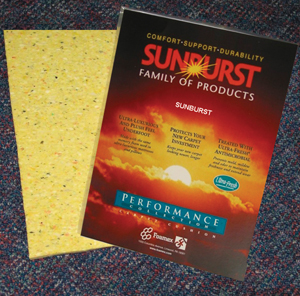 |
| Foamex Products |
|
By Louis Iannaco
Hicksville, N.Y.—Price increases are nothing new to the flooring industry. Fiber, resilient and other segments have had their share, with raw materials and energy costs usually being the culprits. But regarding rebond carpet cushion, what’s been happening in recent months has been festering with no singular or short-term solution in sight.
“I don’t understand it myself,” said Wendy Fried of G. Fried Carpet in Westbury, N.Y. “Every single week; it’s getting ridiculous. How could we have had a sufficient supply of padding when business was good, and now when business is poor, or at a lull, there is a shortage and the prices are skyrocketing?
“People are using less padding, including car dealerships and the bedding industry, and there still is not enough around for us. It’s a case of supply and demand. They say China has our product because they are making more goods for export now. As usual, everything turns to supply and demand and prices go up.”
“It’s a package deal for us which includes installation, so we have had to raise the package for installation,” said
Arnold Graff of
Montauk Carpet & Rug in East Farmingdale, N.Y. “It used to be $10. Now we have had to go to $11. We had to raise it a dollar just to keep up with the increases.”
The main problem, suppliers say, has to do with a shortage of rebond, the multicolored, patchwork cushion which lies underneath most carpeting in the U.S. The question is, what is the reason for the shortage?
“The reasons for the price increases on rebond carpet cushion have to do with the unavailability of urethane scrap,” said
David Wiatrolik, vice president of sales for
Leggett & Platt’s urethane division. “Much of the furniture and bedding industry which generate trim have moved to China. We purchase scrap from Asia, but it is of poor quality. We also buy from the European market but those countries vacation this time of year and are down for a complete month. We expect these shortages will last until the first quarter of 2007. At that time, pricing will soften for a short time and then repeat with shortages.”
Ken Thompsen, vice president of the carpet cushion division of
Carpenter Co., said, “it is not just one thing, it’s a myriad of factors influencing the shortage. The trigger that started all of this was Katrina which shut down many of the different chemical facilities in the South. When that happened, it caused everyone in the foaming industry to produce at much lower levels for about eight or 10 weeks.
“During that period,” he added, “all of us who produce foam were producing roughly half to slightly more than our normal production.”
During that time, noted Thompsen, an immediate shortage was being created. “That in and of itself was not devastating, but much of the supply filters through a fairly small network of brokers. When anybody in a supply-type mode knows there is going to be a shortage, they start holding back on supply knowing whatever they are selling is likely going to be worth more tomorrow than it is today.
“So, as soon as Katrina hit, and there was a little bit of panic because of the shortage of material, the total world supply all of a sudden started to be held back by brokers seizing the opportunity to drive the price up,” he added. “So you had that two-component thing that immediately shot prices up and throughout the fall we had a series of about four price increases.”
Like Thompsen, others agree the reason for the shortage goes back quite a ways and is not a simple issue. “You have to trace it back,” said
Steve Stockwell, executive vice president of
Foamex, a manufacturer of rebond pad. “It started with oil back last fall when the foam industry, not rebond manufacturers, but foam in general were hit by chemical increases as a result of the price of oil and the effects of Hurricane Katrina.
“What happened was, with the increases in chemicals going into the pouring of foam, foam prices went up,” he explained. “Now you have a high value on the foam. The mattress and furniture manufacturers say hey, ‘I’m going to look for a substitute. I don’t need foam, I’m going to use fiber or some other substitute.’ So now you’ve got the foamers [foam manufacturers] across the country and around the globe saying, ‘We don’t need to pour as much foam.’ Now, we are talking in the range of 25% to 30% less foam being poured.
“So then you have less scrap available and because of the foam that is being poured being at such a high value, the people using it aren’t generating as much scrap, they are finding another way of using it,” said Stockwell. “So now there is not enough scrap to the quantity required by the rebond manufacturers. All this has taken time to transpire.
“All of a sudden, there is a shortage, he said. “You can’t get it domestically, you can’t get it in China. It’s just more difficult to get and what you can get the rebond manufacturers are paying a premium for, hence the increases.”
(Editor’s note: In part two, we will look at more reasons for the shortage as well as some alternatives.)